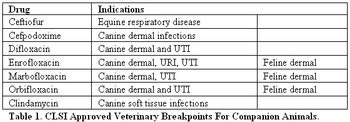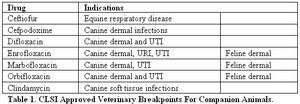
Veterinary pharmacologist Dr. Butch KuKanich gives his thoughts.

Veterinary pharmacologist Dr. Butch KuKanich gives his thoughts.

Let go of these popular misconceptions about opioid use in veterinary patients.

Nonsteroidal antiinflamatory drugs (NSAIDs) are commonly used in veterinary medicine for a variety of reasons including the management of acute postoperative pain and chronic pain associated with degenerative joint disease among other conditions. However adverse effects preclude their use in many patients and severe adverse effects such as nephrotoxicity, hepatotoxicity, and gastrointestinal ulceration and perforation, and death occur infrequently.

Treatment of bacterial infections can be difficult and frustrating. There are many different opinions for empiric antimicrobial therapy.

Nonsteroidal anti-inflammatory drugs (NSAIDs) are the most widely used analgesic drug class in human and veterinary medicine. NSAIDs are effective due to both peripheral and central mechanisms of analgesia.

Shock can be classified into general categories: hypovolemic, maldistribution, and cardiogenic. Hypovolemic shock is due to a diminished volume of fluids and can occur in severe dehydration (Parvoviral gastroenteritis, hemorrhagic gastroenteritis) or hemorrhage.

The vomiting reflex is a complex mechanism that can be initiated peripherally from the GI tract, pharynx, chemoreceptor trigger zone (CRTZ), and vestibular systems or centrally at the emetic center in the brain. Direct stimulation of the pharynx can result in vomiting, although this is a relatively infrequent cause in animals.

Opioids are commonly used in veterinary medicine for their analgesic, sedative, and anti-diarrheal properties. Opioids are also effective antitussive agents and in appropriate doses opioids can provide anxiolytic effects.

Many clients are requesting all natural and alternative treatment options as they are under the impression that they produce less adverse effects than pharmaceutical compounds. This is a common misconception as some of the most toxic compounds known are natural products such as botulinum toxin, ricin, cobra venom, and uranium, among many others.

Morphine cannot be used in cats due to CNS excitement and slow metabolism and morphine causes histamine release in dogs resulting in severe hypotension and the most common adverse effects of opioids are cardiovascular and respiratory depression.

Unasyn 1.5 g vial (Generic ~$4.50) is commercially available containing ampicillin 1 g and sulbactam 0.5 g. Sulbactam is a beta lactamase inhibitor, therefore many people think of this drug as "injectable Clavamox."

Nonsteroidal anti-inflammatory drugs (NSAIDs) are the most widely used analgesic drug class in human and veterinary medicine.

The field of veterinary clinical pharmacology is growing tremendously with new veterinary drugs introduced and with the use of human labeled drugs in veterinary patients.

Shock can be classified into general categories: hypovolemic, maldistribution, and cardiogenic.

The vomiting reflex is a complex mechanism that can be initiated peripherally from the GI tract, pharynx, chemoreceptor trigger zone (CRTZ), and vestibular systems or centrally at the emetic center in the brain.

Busting the top veterinary pharmacology myths.

Nonsteroidal antiinflamatory drugs (NSAIDs) are commonly used in veterinary medicine for a variety of reasons including the management of acute postoperative pain and chronic pain associated with degenerative joint disease among other conditions.

Opioids are commonly used in veterinary medicine for their analgesic, sedative, and anti-diarrhea properties.

Although griseofulvin is the only antifungal approved for systemic administration by the Food and Drug Administration (FDA) for veterinary use, a variety of systemic antifungals are available for use in veterinary medicine.

Published: December 1st 2010 | Updated:

Published: December 1st 2010 | Updated:

Published: August 1st 2010 | Updated:

Published: August 1st 2010 | Updated:

Published: August 1st 2010 | Updated:

Published: August 1st 2010 | Updated: